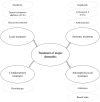Colonization With Staphylococcus aureus in Atopic Dermatitis Patients: Attempts to Reveal the Unknown
- PMID: 33505363
- PMCID: PMC7830525
- DOI: 10.3389/fmicb.2020.567090
Colonization With Staphylococcus aureus in Atopic Dermatitis Patients: Attempts to Reveal the Unknown
Abstract
Atopic dermatitis (AD) patients are massively colonized with Staphylococcus aureus (S. aureus) in lesional and non-lesional skin. A skin infection may become systemic if left untreated. Of interest, the incidence of multi-drug resistant S. aureus (MRSA) in AD patients is higher as compared to a healthy population, which makes treatment even more challenging. Information on the specific genetic background of S. aureus accompanying and/or causing AD flares would be of great importance in terms of possible treatment option development. In this review, we summarized the data on the prevalence of S. aureus in general in AD skin, and the prevalence of specific clones that might be associated with flares of eczema. We put our special interest in the presence and role of staphylococcal enterotoxins as important virulence factors in the epidemiology of AD-derived S. aureus. Also, we summarize the present and potentially useful future anti-staphylococcal treatment.
Keywords: MRSA; antistaphylococcal photodynamic treatment; epidemiology of S. aureus; staphylococcal enterotoxins; virulence factor.
Copyright © 2021 Ogonowska, Gilaberte, Barańska-Rybak and Nakonieczna.
Conflict of interest statement
The authors declare that the research was conducted in the absence of any commercial or financial relationships that could be construed as a potential conflict of interest.
Figures





References
-
- Abad E. D., de Ferreira D. C., Cavalcante F. S., Saintive S., Goudouris E., Prado E. A., et al. (2019). High incidence of acquiring methicillin-resistant Staphylococcus aureus in Brazilian children with atopic dermatitis and associated risk factors. J. Microbiol. Immunol. Infect. 53 724–730. 10.1016/j.jmii.2018.12.014 - DOI - PubMed
-
- Akdis C. A., Akdis M., Bieber T., Bindslev-Jensen C., Boguniewicz M., Eigenmann P., et al. (2006). Diagnosis and treatment of atopic dermatitis in children and adults: European Academy of Allergology and Clinical Immunology/American Academy of Allergy, Asthma and Immunology/PRACTALL consensus report. Allergy Eur. J. Allergy Clin. Immunol. 118 152–169. 10.1111/j.1398-9995.2006.01153.x - DOI - PubMed
-
- Alsterholm M., Strömbeck L., Ljung A., Karami N., Widjestam J., Gillstedt M., et al. (2017). Variation in Staphylococcus aureus colonization in relation to disease severity in adults with atopic dermatitis during a five-month follow-up. Acta Derm. Venereol. 97 802–807. 10.2340/00015555-2667 - DOI - PubMed
-
- Arikawa J., Ishibashi M., Kawashima M., Takagi Y., Ichikawa Y., Imokawa G. (2002). Decreased levels of sphingosine, a natural antimicrobial agent, may be associated with vulnerability of the stratum corneum from patients with atopic dermatitis to colonization by Staphylococcus aureus. J. Invest. Dermatol. 119 433–439. 10.1046/j.1523-1747.2002.01846.x - DOI - PubMed
-
- Arkwright P. D., Cookson B. D., Haeney M. R., Sanyal D., Potter M. R., David T. J. (2001). Children with atopic dermatitis who carry toxin-positive Staphylococcus aureus strains have an expansion of blood CD5- B lymphocytes without an increase in disease severity. Clin. Exp. Immunol. 125 184–189. 10.1046/j.1365-2249.2001.01620.x - DOI - PMC - PubMed
Publication types
LinkOut - more resources
Full Text Sources
Other Literature Sources
Medical

